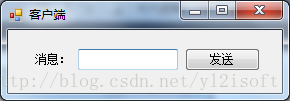1 新建解决方案NamedPipeExample
在解决方案下面新建两个项目:Client和Server,两者的输出类型均为“Windows 应用程序”。整个程序的结构如下图所示。
2 实现项目Client
Client仅包含一个名为“客户端”的窗体,如下图所示。

编写窗体后端代码,如下所示。
using System;
using System.IO;
using System.IO.Pipes;
using System.Security.Principal;
using System.Windows.Forms;
namespace Client
{
public partial class frmClient : Form
{
NamedPipeClientStream pipeClient =
new NamedPipeClientStream("localhost", "testpipe", PipeDirection.InOut, PipeOptions.Asynchronous, TokenImpersonationLevel.None);
StreamWriter sw = null;
public frmClient()
{
InitializeComponent();
}
private void frmClient_Load(object sender, EventArgs e)
{
try
{
pipeClient.Connect(5000);
sw = new StreamWriter(pipeClient);
sw.AutoFlush = true;
}
catch (Exception ex)
{
MessageBox.Show("连接建立失败,请确保服务端程序已经被打开。");
this.Close();
}
}
private void btnSend_Click(object sender, EventArgs e)
{
if (sw != null)
{
sw.WriteLine(this.txtMessage.Text);
}
else
{
MessageBox.Show("未建立连接,不能发送消息。");
}
}
}
}3 实现项目Server
Server项目仅包含一个名为“服务端”的窗体,如下图所示。
编写窗体后端代码,如下所示。
using System;
using System.IO;
using System.IO.Pipes;
using System.Threading;
using System.Windows.Forms;
namespace Server
{
public partial class frmServer : Form
{
NamedPipeServerStream pipeServer =
new NamedPipeServerStream("testpipe", PipeDirection.InOut,1,PipeTransmissionMode.Message,PipeOptions.Asynchronous);
public frmServer()
{
InitializeComponent();
}
private void frmServer_Load(object sender, EventArgs e)
{
ThreadPool.QueueUserWorkItem(delegate
{
pipeServer.BeginWaitForConnection((o) =>
{
NamedPipeServerStream pServer = (NamedPipeServerStream)o.AsyncState;
pServer.EndWaitForConnection(o);
StreamReader sr = new StreamReader(pServer);
while (true)
{
this.Invoke((MethodInvoker)delegate { lsvMessage.Items.Add(sr.ReadLine()); });
}
}, pipeServer);
});
}
}
}
4 运行程序
运行Server.exe与Client.exe程序,效果如下图所示。
实例中共发送三次消息,分别传递数据1,2,3。
本例中演示的客户端和服务端程序均位于本地机器,使用命名管道可以与网络上的其他进程进行通信。





 本文介绍如何使用C#实现一个简单的客户端和服务端应用,通过命名管道进行通信。客户端能够向服务端发送消息,并在服务端接收并显示这些消息。
本文介绍如何使用C#实现一个简单的客户端和服务端应用,通过命名管道进行通信。客户端能够向服务端发送消息,并在服务端接收并显示这些消息。



















 535
535

 被折叠的 条评论
为什么被折叠?
被折叠的 条评论
为什么被折叠?








